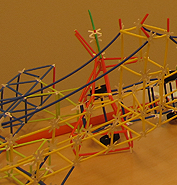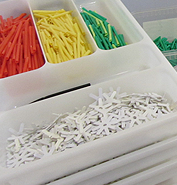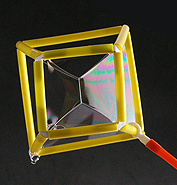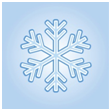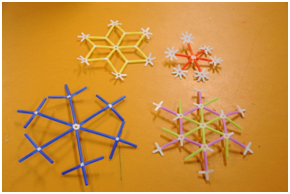4DFrame Activity Tips:
5. Snowflakes
Build different snowflakes. All snowflakes have six sides, but can still look very
different.
KomTek in Järfalla is a Swedish science- and technology-oriented activity centre
that regularly uses 4DFrame materials in its programs both in-house and with local
schools. Anna Nytomt Kristensson is one of their staff who works with this and she
shared this set of activity tips KomTek developed (thank you, Anna!) for using this
educational teaching tool.
5. Snowflakes
Build different snowflakes. All snowflakes have six sides, but can still look very
different.
Main concepts 1-3 mathematics:
- Symmetry as found, for example, in nature and in artwork, and how symmetry can
be constructed.
- Basic geometric objects including points, lines, line segments, quadrilaterals,
triangles, circles, spheres, cones, cylinders and cuboids and their mutual relations.
Basic geometrical attributes of these objects.
Main concepts 1-3 technology:
- Materials for your own design work, their properties, and how they can be connected.
Main concepts 4-6 mathematics:
- Basic geometric objects such as polygons, circles, spheres, cones, cylinders, pyramids
and cuboids and their mutual relations. Basic geometric properties of these objects.
-Construction of geometric objects.
- Symmetry in everyday life, in art, in nature, and how symmetry can be constructed.
Main concepts 4-6 technology:
- Own designs with applications of the principles of solid and stable structures.
Preparation:
- Discuss the number six. How many is that? How can the number six be divided up?
A snowflake always has six "sides."
- Work with simple symmetry exercises. Watch a butterfly and notice how it is the
same on both wings . Show what symmetry is, paint your own symmetry images. http://www.ungafakta.se/pyssel/skapa/fjarilar/
- Build symmetrical patterns with blocks.
- Look for examples of symmetry around you.
- Talk about the form of snowflakes and explain why it looks that way. Look at pictures
of snowflakes; Wilson Bentley is a well-known photographer who took many pictures
of snowflakes.
- A Japanese scientist named Nakaya explained how snowflakes get their unique shapes
. It is a question of at what height and at which temperature the crystal finds itself
on its way to the ground. It all starts with a tiny ice crystal. It is hexagonal
due to water molecules form and how water molecules way that bind to each other.
Just as René Descartes had already noted in the 1600's, the crystals are so light
they float around in the clouds, and the wind snatches them hither and dither. Bit
by bit they build along the six edges of the crystal, and eventually developed six
arms. The temperature constantly changes, and each flake has its own unique combination
of different temperatures. But the pattern of the six arms of each snowflake is followed
the whole way, and all parts experience the same experiences of changing altitude
and temperature. This makes the six arms alike.
Snowflakes with 4DFrame:
Build snowflakes with 4DFrame, making different sizes and different patterns. Keep
in mind that they always have six "arms" and are symmetrical. Begin by starting with
a connection having six arms for the center.
Follow-up:
- Look at the geometric forms found in your snowflakes.
- If it is winter, look at real snowflakes with a magnifying glass.
- Fold and cut your own paper snowflakes.
http://katarinaskoppar.blogspot.se/p/klipp-en-snoflinga.html
http://www.spelochpyssel.com/jul/julpyssel_runda_snostjar nor.htm
http://www.365slojd.se/?p=5477
- You can download a program called Kali where children can make symmetrical patterns.
Be sure to try it for yourself first!
http://www.geometrygames.org/Kali/index.html
Top of page
©2013-2015, Nordic4DFrame AB
Grönviksvägen 6, 185 41 Vaxholm, Sweden

